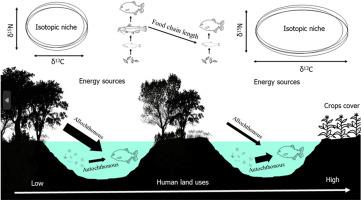Land use extent and intensity affect the trophic structure of apex fish in neotropical lagoons
IF 4.4
Q1 ENVIRONMENTAL SCIENCES
引用次数: 0
Abstract
The conversion of natural ecosystems to human land use is a primary cause of worldwide biodiversity loss and trophic structure changes in ecosystems. We investigated the effect of human land use at different spatial extents and aquatic trophic state on basal energy sources, food chain length (FCL), and the isotopic niche of apex fish in four large neotropical wetlands. We had two hypotheses. (i) Increased regional human land is negatively associated with the contributions of allochthonous energy sources, FCL, and isotopic niche. (ii) Trophic state is directly associated with FCL, autochthonous energy source, and niche area. We found that C3 riparian vegetation was the primary energy source for apex consumers. Human land uses in a 5000 m buffer were directly associated with allochthonous basal-energy source assimilation and niche area and indirectly with FCL. FCL was shorter in environments with more human land use and allochthonous energy source assimilation had an important role on FCL. Therefore, conserving riparian vegetation surrounding water bodies is a crucial protective factor for waters, as it serves as a primary energy source for food webs. Decreased FCL with increased human activity demonstrated the sensitivity of these environments to trophic-link losses from human invasion. Conversely, increased isotopic niche areas in environments with high human activities may be attributed to the introduction of new energy sources from those activities. Hence, the loss of natural cover resulting from human activities is an important factor in aquatic trophic structure changes.

土地利用程度和强度影响新热带泻湖顶端鱼类的营养结构
自然生态系统向人类土地利用的转变是全球生物多样性丧失和生态系统营养结构变化的主要原因。研究了4个大型新热带湿地不同空间尺度和水生营养状态下人类土地利用对湿地基础能量来源、食物链长度和顶端鱼类同位素生态位的影响。我们有两个假设。(i)区域人类土地的增加与外来能源、植被覆盖度和同位素生态位的贡献呈负相关。(ii)营养状态与植被总量、原生能量来源和生态位面积直接相关。研究发现,C3河岸植被是顶端消费者的主要能量来源。5000 m缓冲带的人类土地利用与异域基底能源同化和生态位面积直接相关,与植被覆盖度间接相关。在人类土地利用程度较高的环境中,植被覆盖度较短,异域能源同化对植被覆盖度有重要影响。因此,保护水体周围的河岸植被是水的重要保护因素,因为它是食物网的主要能量来源。随着人类活动的增加,FCL的降低表明这些环境对人类入侵造成的营养链损失的敏感性。相反,在人类活动频繁的环境中,同位素生态位面积的增加可能是由于人类活动引入了新能源。因此,人类活动导致的自然覆盖的丧失是水生营养结构变化的重要因素。
本文章由计算机程序翻译,如有差异,请以英文原文为准。
求助全文
约1分钟内获得全文
求助全文

 求助内容:
求助内容: 应助结果提醒方式:
应助结果提醒方式:


